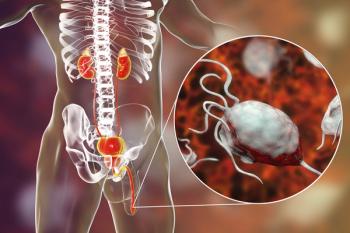
ASCO: Sulforaphane in Prostate Cancer Found Worthy of Further Investigation
Treatment with 200 µmol per day of sulforaphane for 20 weeks was “feasible, safe,” and inhibited histone deacetylase (HDAC) function in a single-arm study of 20 patients who had non-castrate biochemical (PSA)-recurrence of prostate cancer despite surgery or radiation.
CHICAGO-Treatment with 200 µmol per day of sulforaphane for 20 weeks was “feasible, safe,” and inhibited histone deacetylase (HDAC) function in a single-arm study of 20 patients who had non-castrate biochemical (PSA)-recurrence of prostate cancer despite surgery or radiation (
Ball-and-stick model of sulforaphane
“Our own preclinical work demonstrated that sulforaphane inhibits HDAC function and suppresses androgen receptor signaling in prostate cancer cells,” he continued. “A variety of mechanisms have been implicated for these effects. The antitumor efficacy and safety of sulforaphane in men with prostate cancer, however, was unknown.”
The primary endpoint was PSA response rate (> 50% decline in PSA). Other efficacy endpoints included maximal PSA decline and PSA doubling time changes using a mixed effects model. Genotyping for the GSTM1 gene, which contributes to sulforaphane metabolism; sulforaphane pharmacokinetics, and pharmacodynamic measures of HDAC inhibition in peripheral blood mononuclear cells were also performed.
Of 20 patients enrolled, 16 (80%) completed the preplanned 20 weeks of treatment. One patient experienced a PSA decline > 50%. Thirty-five percent of patients had lesser PSA declines (3% to 20%), and 15% of patients had a final PSA lower than baseline.
“There was a significant reduction in PSA doubling time (6 months pre-study vs 9.4 months on-study, P = .013),” said Alumkal. “Of note, testosterone levels remained non-castrate in all subjects.” Pharmacokinetics analysis demonstrated that GSTM1 null genotype correlated with longer sulforaphane half-life (2.6 hours for GSTM1 null vs 2.1 hours for GSTM1 intact, P = .04). Pharmacodynamic assays showed increased histone acetylation with sulforaphane treatment. “Finally, no grade 3 adverse events were seen, and only one patient discontinued study treatment for toxicity (grade 1 GI discomfort).”
These findings, combined with the preliminary observation of PSA modulation possibly indicative of biologic activity, “provides the basis for dose-escalation studies of sulforaphane in men with prostate cancer,” concluded Alumkal and colleagues. “Studies to identify other pharmacogenomic mediators of sulforaphane metabolism are warranted.”
Additional work is required before dose-escalation studies are undertaken, Alumkal explained in an interview following his presentation. “The compound we used is limited by not having several species toxicity, which will be necessary prior to dose escalation….Groups are working on developing a synthetic version with druglike properties. There are also OTC preparations, but I am not that familiar with their quality control.
“Our results are very early,” he continued, “but we do believe our trial shows a signal with PSA declines and slowing of the rate of PSA change. Larger studies will be necessary to determine the role of sulforaphane in patient management.”
Commenting on the findings, Silke Gillessen, MD, of Kantonsspital St. Gallen, Switzerland, said, “A strength of the study is that it addresses the new field of epigenetic therapy and patients do like natural therapies. Up till now there is only preliminary evidence that sulforaphane really inhibits HDAC.” Although the clinical effects of sulforaphane on disease were modest at the dose studied, she continued, “Even a slowing down of the disease in this setting can be helpful for patient and physician satisfaction, especially when the treatment is well tolerated.”
Newsletter
Stay up to date on recent advances in the multidisciplinary approach to cancer.


















































































